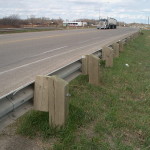Rock Quality Designation (RQD) is a test used by geotechnical engineers to indicate the degree of fracture of a drill core. It is a simple process which involves counting up the pieces of drill core which are more than 10 cm long and fully intact. The percentage of the whole drill core length is the […]
How to Calculate the First Moment of Area
In structural engineering applications, the first moment of area is a calculation that is used to determine shear stress distributions. It is a relatively simple concept which involves the moment of a surface around an axis. $latex Q_y = x_c A\newline\newline Q_x = y_c A&s=2$ Where: Qx = first moment around the x axis (ft3 […]
Soil Particle Size Distribution
Soil contains four primary components, for engineering purposes: gravel sand silt clay Organic material can be present in surface samples as well but this has no relevance to engineering applications. Gravel and sand are classified as coarse-grained, whereas silt and clay are classified as fine-grained. Various classification schemes exist which attempt to define the grain […]
Pipe Standards
There are many different standards governing the different types of pipe material, diameters and wall thicknesses. The following are a list of standards in place in the United States: Gasketed PVC sewer pipe Smaller than 15 in. diameter: ASTM D3034. Greater than 15 in. diameter: ASTM F679. PVC pressure pipe for water distribution: AWWA C900. […]
Types of Pipe Material
Pipe materials are chosen to withstand internal pressures, external loads from backfill and traffic, smoothness, corrosion resistance, chemical inertness, cost, and other factors. The major types of pipe material that are in use today are: Plastic Steel Concrete Copper and brass Cast iron Vitrified clay Plastic Pipe Subdivided into PVC and ABS pipe, plastic pipe […]
How to calculate Turbulent Flow
Turbulent flow is rough and choppy. Turbulent flow is the opposite of laminar flow, which is straight line flow. In pipelines, laminar flow occurs when Reynolds number is greater than 4,000. $latex R_e > 4,000&s=2$ If a stream of dye is inserted into the flow and it disperses and mixes, the flow is turbulent. When […]
How to determine Laminar Flow
Laminar flow is smooth flow in a straight line. Laminar is the opposite of turbulent flow. In pipelines, laminar flow occurs when Reynolds number is less than 2,100. $latex R_e < 2,100&s=2$ If a stream of dye is inserted into the flow and it continues in a straight, unbroken line, the flow is laminar. Flow […]
How to Calculate Reynold’s Number
The Reynolds number of a fluid is a dimensionless constant which allows you to determine whether the flow of a fluid is laminar or turbulent. It represents the ratio of inertial forces to viscous forces in the fluid. $latex R_e = \frac{inertial forces}{viscous forces}&s=2$ The equation is: $latex R_e = \frac{D_ev}{\upsilon}&s=2$ Where: De = Hydraulic […]
How to Calculate Hydraulic Diameter
The hydraulic diameter is a term used in fluid mechanics and thermodynamics. It is a measure of the efficiency of a section to pass flow by relating the cross-sectional area of flow to the wetted perimeter of the cross-section. The hydraulic diameter of a round pipe is simply its diameter. The equations for hydraulic diameter […]









